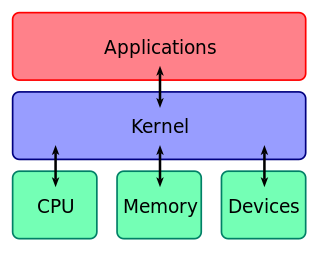In IBM mainframe operating systems, basic partitioned access method (BPAM) [1] is an access method for libraries, called partitioned datasets (PDSes) in IBM terminology. BPAM is used in OS/360, OS/VS2, MVS, z/OS, and others.
IBM mainframes are large computer systems produced by IBM since 1952. During the 1960s and 1970s, IBM dominated the large computer market. Current mainframe computer in IBM's line of business computers are developments of the basic design of the IBM System/360.

An operating system (OS) is system software that manages computer hardware and software resources and provides common services for computer programs.
An access method is a function of a mainframe operating system that enables access to data on disk, tape or other external devices. They were introduced in 1963 in IBM OS/360 operating system. Access methods provide an application programming interface (API) for programmers to transfer data to or from device, and could be compared to device drivers in non-mainframe operating systems, but typically provide a greater level of functionality.
Contents
A PDS consists of members (internally identical to sequential data sets), registered in a list called the directory. The combination of members and directory is a single dataset on disk. The directory contains a list of member's names (8 characters, padded on the right with blanks, as required) and member's addresses. Addresses are relative to the start of the dataset in order to allow the PDS to be moved to a different disk location.
In the context of IBM mainframe computers, a data set or dataset is a computer file having a record organization. Use of this term began with OS/360 and is still used by its successors, including the current z/OS. Documentation for these systems historically preferred this term rather than file.
Partitioned datasets can store any type of data, but they are often used to store executable programs, or load modules, sometimes called binaries in other systems. Other uses include system assembler macro definitions, job control procedures, and program source code.

In computing, executable code or an executable file or executable program, sometimes simply referred to as an executable, causes a computer "to perform indicated tasks according to encoded instructions", as opposed to a data file that must be parsed by a program to be meaningful.

A macro in computer science is a rule or pattern that specifies how a certain input sequence should be mapped to a replacement output sequence according to a defined procedure. The mapping process that instantiates (transforms) a macro use into a specific sequence is known as macro expansion. A facility for writing macros may be provided as part of a software application or as a part of a programming language. In the former case, macros are used to make tasks using the application less repetitive. In the latter case, they are a tool that allows a programmer to enable code reuse or even to design domain-specific languages.
Job Control Language (JCL) is a name for scripting languages used on IBM mainframe operating systems to instruct the system on how to run a batch job or start a subsystem.

